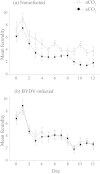Virus infection mediates the effects of elevated CO2 on plants and vectors
- PMID: 26941044
- PMCID: PMC4778167
- DOI: 10.1038/srep22785
Virus infection mediates the effects of elevated CO2 on plants and vectors
Abstract
Atmospheric carbon dioxide (CO2) concentration has increased significantly and is projected to double by 2100. To increase current food production levels, understanding how pests and diseases respond to future climate driven by increasing CO2 is imperative. We investigated the effects of elevated CO2 (eCO2) on the interactions among wheat (cv. Yitpi), Barley yellow dwarf virus and an important pest and virus vector, the bird cherry-oat aphid (Rhopalosiphum padi), by examining aphid life history, feeding behavior and plant physiology and biochemistry. Our results showed for the first time that virus infection can mediate effects of eCO2 on plants and pathogen vectors. Changes in plant N concentration influenced aphid life history and behavior, and N concentration was affected by virus infection under eCO2. We observed a reduction in aphid population size and increased feeding damage on noninfected plants under eCO2 but no changes to population and feeding on virus-infected plants irrespective of CO2 treatment. We expect potentially lower future aphid populations on noninfected plants but no change or increased aphid populations on virus-infected plants therefore subsequent virus spread. Our findings underscore the complexity of interactions between plants, insects and viruses under future climate with implications for plant disease epidemiology and crop production.
Figures






References
-
- IPCC. Climate Change 2013: The Physical Science Basis. Contribution of Working Group I to the Fifth Assessment Report of the Intergovernmental Panel on Climate Change (Cambridge University Press, 2013).
-
- Kimball B. A., Kobayashi K. & Bindi M. In Advances in Agronomy Vol. 77 (ed Donald L. Sparks) 293–368 (Academic Press, 2002).
-
- Drake B. G., Gonzàlez-Meler M. A. & Long S. P. More efficient plants: a consequence of rising atmospheric CO2? Annu. Rev. Plant Biol. 48, 609–639 (1997). - PubMed
Publication types
MeSH terms
Substances
LinkOut - more resources
Full Text Sources
Other Literature Sources

